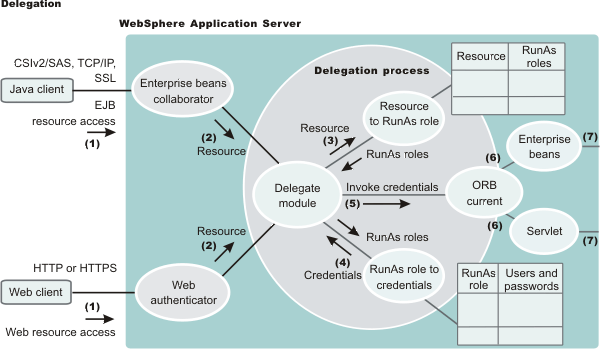WAS v8.5 > Secure applications > Authorizing access to resources > Authorization technology
Delegations
Delegation is a process security identity propagation from a caller to a called object. As per the Java EE specification, a servlet and enterprise beans can propagate either the client or remote user identity when invoking enterprise beans, or they can use another specified identity as indicated in the corresponding deployment descriptor.
The extension supports enterprise bean propagation to the server ID when invoking other entity beans. Three types of delegations are possible:
- Delegate (RunAs) client identity
- Delegate (RunAs) specified identity
- Delegate (RunAs) system identity



The RunAs system identity delegation only works when server ID and password are used. When the internalServerId feature is used, it does not work because runAs with system identity is not supported. Specify RunAs roles. When internalServerID is used, use the RunAsSpecified with a user ID and password that is mapped to the administrator role. See Administrative roles and naming service authorization for more information about internalServerId.
The EJB specification only supports delegation (RunAs) at the EJB level. But an extension allows EJB method-level RunAs specification. With an EJB method level, the RunAs specification can specify a different RunAs role for different methods within the same enterprise beans.
The RunAs specification is detailed in the deployment descriptor, which is the ejb-jar.xml file in the EJB module and web.xml in the web module. The extension to the RunAs specification is included in the ibm-ejb-jar-ext.xml file.
An IBM-specific binding file is available for each application containing a mapping from the RunAs role to the user. This file is specified in the ibm-application-bnd.xml file.
These specifications are read by the runtime during application startup. The following figure illustrates the delegation mechanism, as implemented in the WAS security model.

Delegation Process
Two tables help in the delegation process:
- Resource to RunAs role mapping table
- RunAs role to user ID and password mapping table
Use the Resource to RunAs role mapping table to get the role used by a servlet or by enterprise beans to propagate to the next enterprise beans call.
Use the RunAsRole to user ID and password mapping table to get the user ID that belongs to the RunAs role and its password.
Delegation is performed after successful authentication and authorization. During this process, the delegation module consults the Resource to RunAs role mapping table to get the RunAs role (3). The delegation module consults the RunAs role to user ID and password mapping table to get the user that belongs to the RunAs role (4). The user ID and password is used to create a new credential using the authentication module, which is not shown in the figure.
The resulting credential is stored in the ORB Current as an invocation credential (5). Servlet and enterprise beans when invoking other enterprise beans pick up the invocation credential from the ORB Current (6) and call the next enterprise beans (7).